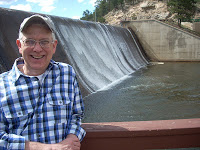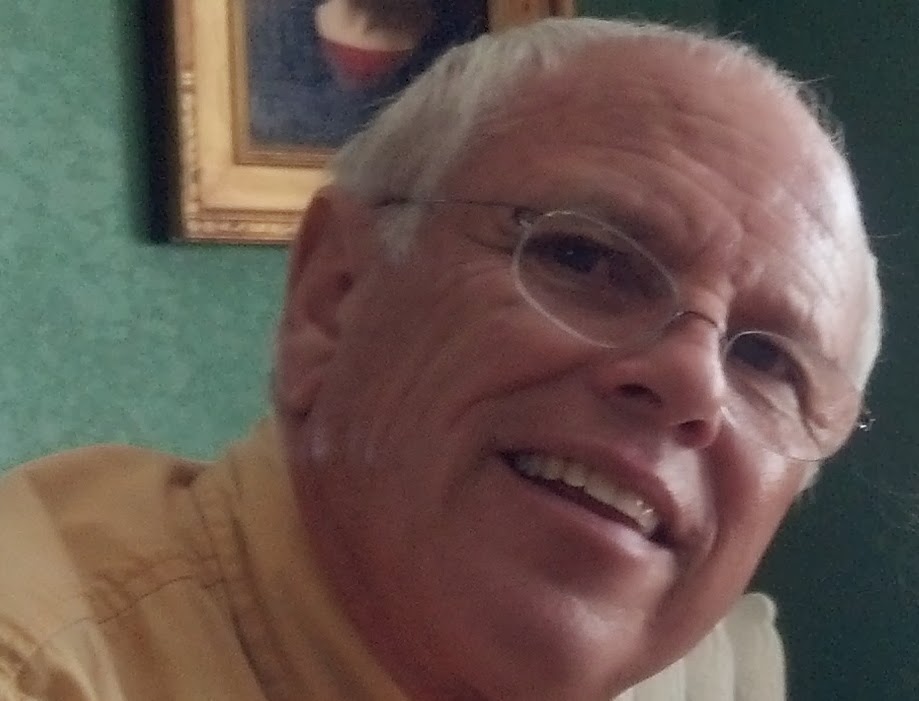Park on South Washington Street to ride the miniature train. It puffed around
the perimeter of the park back then and to me seemed as real as could be, an
adventure of movement, a fascination with technology, a feeling of the wind on
one’s face while traveling at imagined breakneck speed. I’m sure I thought of
bandits or Indians like in some western movies I had seen. Of course the kiddy
train was tiny compared with the big black steam engines that pulled box cars,
fuel cars, grain cars, and the like. It was tiny compared with the big Union
Pacific passenger trains that came into our station at Junction City, Kansas.
train at the Cheyenne Mountain Zoo up above Colorado Springs, a train that for
years took passengers from the zoo to the Shrine to the Sun higher upon the
mountain. To four-year-old me it seemed gigantic but still would have looked puny
next to the Union Pacific trains back home. I was decked out in my western wear
at the Cheyenne Mountain Zoo. Back home I would simply be a little boy, but
even at home the railroad loomed large. My grade-school best friend’s father
was an oil man on the Union Pacific and greeted and lubricated all the trains
on his daily shifts. I fantasized taking a trip by train, a real one that led
to something new.
later, a Sunday morning that turned traumatic for our mid-Missouri congregation,
I heard a train whistle blow as if to call me away. That morning the senior minister Jack McInnis
died. He and I had worked with the church for seven years. My only thought was to
get on that train and get out of there. I did so two years later when I booked
a seat on the Southwest Chief to Albuquerque. But first I caught a ride on the
Amtrak that stopped at Jefferson City on its way to Kansas City. There I ran
around for a day with a dear friend to say goodbye.
make my way west. At KC Union Station there was a long delay. We waited and
waited for the very late train. When we boarded, I got comfortable and waited
for the train to start moving. No go! I got out a book to read. (On trips I’m
always prepared to read.) I made my way through several chapters. Still the
train sat in the dark rail yard. Finally after three hours more the train took
off. There had been engine trouble. No quick fixes were available and no extra
engines could be substituted unless the train had been sitting on the track at Chicago
or Emeryville (near San Francisco)! We made our way across the Great Plains at
night.
Great Grandfather, Frederick Schmedemann, a German immigrant who in the late
1860s worked for the Union Pacific as its crews laid the first track across
Kansas. He cooked for the crew and during that time met William Cody who was
supplying meat for the workers at the expense of the vast and rapidly dwindling
buffalo population after which he was named. The family story says Buffalo Bill
was so pleased with the meal my great granddad prepared, he gave him a gold
piece. By the time I came along, though, there had been way too many
depressions in the US economy. The gold piece probably went towards improving
the farm or paid some doctor for caring for a family member with the flu. Who
knows? I never saw it, never heard any subsequent stories about it. Maybe it
was lost on a bet or paid for the first year’s coverage when crop insurance
first was introduced. There were such stories about those later days on the
farm, but no gold piece.
summer morning through the window I watched rabbits, deer, and groups of
domesticated cattle (no buffalo herds of course) and thought more about my
great grandfather, his new life in America, and the new life I was hoping to
begin in Albuquerque. Finally, I got a little breakfast, after which I returned
to my novel.
and for parents with little children. But when compared with wagon train travel
down the Santa Fe Trail, this mode of transportation was a breeze. That afternoon, when we were starting up
Raton Pass, the train slowed to a stop and began backing up. The engineer
announced that a switch had failed. They would change it by hand to get us on
the sidetrack where we would be safe from the train hurtling down the pass
towards us now. When that train sped safely by, we still didn’t move. The
engineer said a computer engineer was on his way from La Junta, Co, to fix the
problem with the switch. I chose this time to clean up and shave so I’d look
good for my family. Finally, finally, finally we pulled into the Albuquerque
station where my family met me and drove me to our new apartment. The reunion
was grand, and a couple of days later I began a new job in that fair city.
lives in Denver and spends his time writing, painting, and socializing. In
general he keeps busy with groups of writers and artists. Following thirty-two
years in church work and fifteen in a therapeutic massage practice, he now
focuses on creating beauty. He volunteers at The Center leading the SAGE
program “Telling Your Story.”


